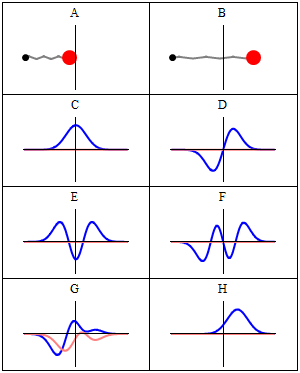Stationary state
A stationary state is called stationary because the system remains in the same state as time elapses, in every observable way.For a single-particle Hamiltonian, this means that the particle has a constant probability distribution for its position, its velocity, its spin, etc.[1] (This is true assuming the particle's environment is also static, i.e. the Hamiltonian is unchanging in time.)The wavefunction itself is not stationary: It continually changes its overall complex phase factor, so as to form a standing wave.The oscillation frequency of the standing wave, multiplied by the Planck constant, is the energy of the state according to the Planck–Einstein relation.is plugged into the time-dependent Schrödinger equation, the result is[2]Therefore, a stationary state is a standing wave that oscillates with an overall complex phase factor, and its oscillation angular frequency is equal to its energy divided byAs shown above, a stationary state is not mathematically constant:However, all observable properties of the state are in fact constant in time.represents a simple one-dimensional single-particle wavefunctionwhich is independent of the time t. The Heisenberg picture is an alternative mathematical formulation of quantum mechanics where stationary states are truly mathematically constant in time.As mentioned above, these equations assume that the Hamiltonian is time-independent.Spontaneous decay complicates the question of stationary states.But in reality, only the ground state 1s is truly "stationary": An electron in a higher energy level will spontaneously emit one or more photons to decay into the ground state.[3] This seems to contradict the idea that stationary states should have unchanging properties.An orbital is a stationary state (or approximation thereof) of a one-electron atom or molecule; more specifically, an atomic orbital for an electron in an atom, or a molecular orbital for an electron in a molecule.However, for a many-electron molecule, an orbital is completely different from a total stationary state, which is a many-particle state requiring a more complicated description (such as a Slater determinant).This concept of an orbital is only meaningful under the approximation that if we ignore the electron–electron instantaneous repulsion terms in the Hamiltonian as a simplifying assumption, we can decompose the total eigenvector of a many-electron molecule into separate contributions from individual electron stationary states (orbitals), each of which are obtained under the one-electron approximation.(Luckily, chemists and physicists can often (but not always) use this "single-electron approximation".)In chemistry, calculation of molecular orbitals typically also assume the Born–Oppenheimer approximation.

Quantum mechanicsSchrödinger equationIntroductionGlossaryHistoryClassical mechanicsOld quantum theoryBra–ket notationHamiltonianInterferenceComplementarityDecoherenceEntanglementEnergy levelMeasurementNonlocalityQuantum numberSuperpositionSymmetryTunnellingUncertaintyWave functionCollapseBell's inequalityCHSH inequalityDavisson–GermerDouble-slitElitzur–VaidmanFranck–HertzLeggett inequalityLeggett–Garg inequalityMach–ZehnderPopperQuantum eraserDelayed-choiceSchrödinger's catStern–GerlachWheeler's delayed-choiceOverviewHeisenbergInteractionMatrixPhase-spaceSchrödingerSum-over-histories (path integral)Klein–GordonRydbergInterpretationsBayesianConsistent historiesCopenhagende Broglie–BohmEnsembleHidden-variableSuperdeterminismMany-worldsObjective-collapseQuantum logicRelationalTransactionalVon Neumann–WignerRelativistic quantum mechanicsQuantum field theoryQuantum information scienceQuantum computingQuantum chaosEPR paradoxDensity matrixScattering theoryQuantum statistical mechanicsQuantum machine learningAharonovBlackettde BroglieComptonDavissonEhrenfestEinsteinEverettFeynmanGlauberGutzwillerHilbertJordanKramersLandauMoseleyMillikanPlanckSimmonsSommerfeldvon NeumannWignerZeemanZeilingerquantum stateobservableseigenvectorenergy operatorquantum superpositioneigenketatomic orbitalmolecular orbitalharmonic oscillatorspringwavefunctionstanding wavesPlanck constantprobability distributionphase factorstanding wavePlanck–Einstein relationquantum statesHamiltonian operatorreal numbereigenvalue equationlinear operatordifferential equationangular frequency
ℏ
{\displaystyle \hbar }
superposition stateHeisenberg picturemathematical formulation of quantum mechanics1s electronhydrogen atomnonrelativistic
